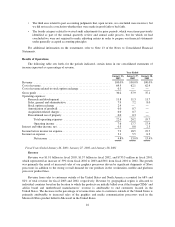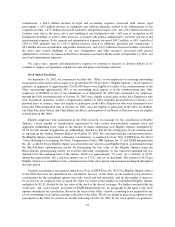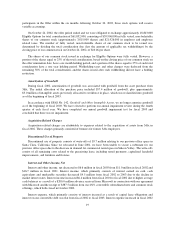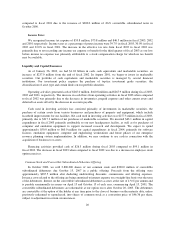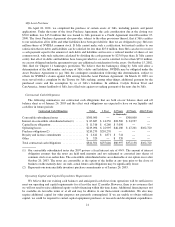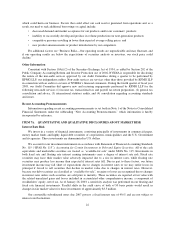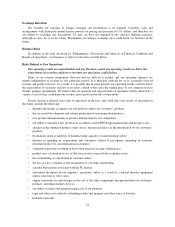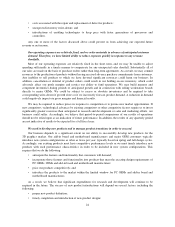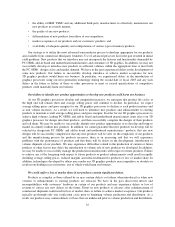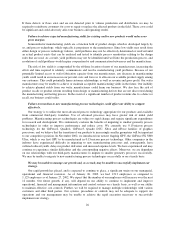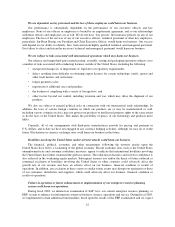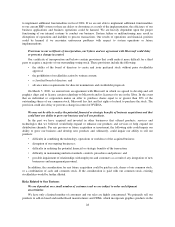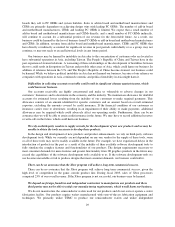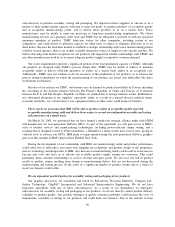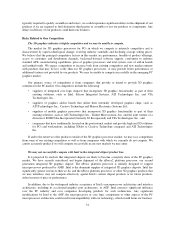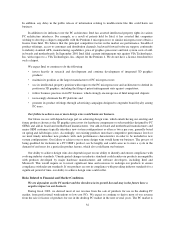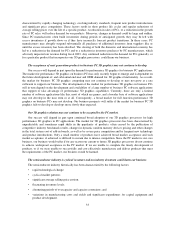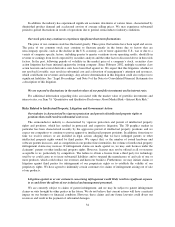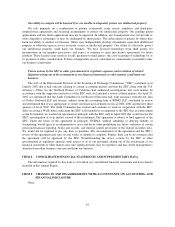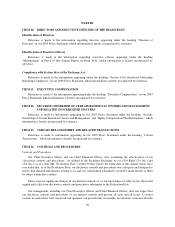NVIDIA 2003 Annual Report Download - page 28
Download and view the complete annual report
Please find page 28 of the 2003 NVIDIA annual report below. You can navigate through the pages in the report by either clicking on the pages listed below, or by using the keyword search tool below to find specific information within the annual report.If these defects or flaws exist and are not detected prior to volume production and distribution, we may be
required to reimburse customers for costs to repair or replace the affected products in the field. These costs could
be significant and could adversely affect our business and operating results.
Failure to achieve expected manufacturing yields for existing and/or new products would reduce our
gross margins.
Semiconductor manufacturing yields are a function both of product design, which is developed largely by
us, and process technology, which typically is proprietary to the manufacturer. Since low yields may result from
either design or process technology failures, yield problems may not be effectively determined or resolved until
an actual product exists that can be analyzed and tested to identify process sensitivities relating to the design
rules that are used. As a result, yield problems may not be identified until well into the production process, and
resolution of yield problems would require cooperation by and communication between us and the manufacturer.
The risk of low yields is compounded by the offshore location of most of our manufacturers, increasing the
effort and time required to identify, communicate and resolve manufacturing yield problems. Because of our
potentially limited access to wafer fabrication capacity from our manufacturers, any decrease in manufacturing
yields could result in an increase in our per unit costs and force us to allocate our available product supply among
our customers. This could potentially harm customer relationships, as well as revenue and gross profit. Our wafer
manufacturers may be unable to achieve or maintain acceptable manufacturing yields in the future. Our inability
to achieve planned yields from our wafer manufacturers could harm our business. We also face the risk of
product recalls or product returns resulting from design or manufacturing defects that are not discovered during
the manufacturing and testing process. In the event of a significant number of product returns due to a defect or
recall, our business could suffer.
Failure to transition to new manufacturing process technologies could affect our ability to compete
effectively.
Our strategy is to utilize the most advanced process technology appropriate for our products and available
from commercial third-party foundries. Use of advanced processes may have greater risk of initial yield
problems. Manufacturing process technologies are subject to rapid change and require significant expenditures
for research and development. We continuously evaluate the benefits of migrating to smaller geometry process
technologies in order to improve performance and reduce costs. We currently use 0.15-micron process
technology for the GeForce4, Quadro4, GeForce3, Quadro DCC, Xbox and nForce families of graphics
processors, and we believe that the transition of our products to increasingly smaller geometries will be important
to our competitive position. In November 2002, we introduced our newest flagship GPU, the GeForce FX 5800
Ultra, which is our first GPU to be manufactured in 0.13-micron process technology. Other companies in the
industry have experienced difficulty in migrating to new manufacturing processes and, consequently, have
suffered reduced yields, delays in product deliveries and increased expense levels. We have experienced and may
continue to experience similar difficulties and the corresponding negative effects. Moreover, we are dependent
on our relationships with our third-party manufacturers to migrate to smaller geometry processes successfully.
We may be unable to migrate to new manufacturing process technologies successfully or on a timely basis.
We may be unable to manage our growth and, as a result, may be unable to successfully implement our
strategy.
Our rapid growth has placed, and is expected to continue to place, a significant strain on our managerial,
operational and financial resources. As of January 26, 2003, we had 1,513 employees as compared to
1,123 employees as of January 27, 2002. We expect that the number of our employees will increase over the next
12 months. Our future growth, if any, will depend on our ability to continue to implement and improve
operational, financial and management information and control systems on a timely basis, as well as our ability
to maintain effective cost controls. Further, we will be required to manage multiple relationships with various
customers and other third parties. Our systems, procedures or controls may not be adequate to support our
operations and our management may be unable to achieve the rapid execution necessary to successfully
implement our strategy.
26


